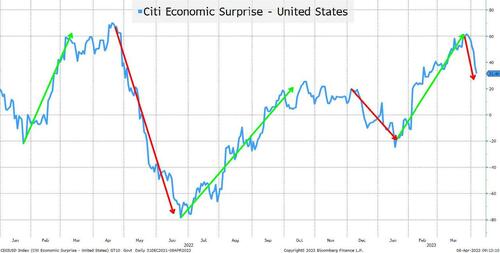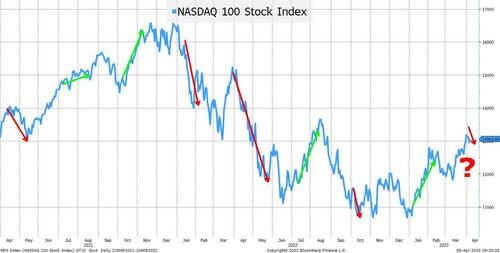


By Peter Tchir of Academy Securities
Spoiler alert – if you started watching Daisy Jones and the Six thinking that the ending might be more uplifting than the description of the show, it isn’t. While I’m not quite as bearish as the title suggests (Davy Jones Locker isn’t good), I remain cautious on risky assets.
This chart is so simplistic (and has so many spurious correlations) that I’m almost embarrassed to publish it, yet here it is.
I am not sure if we are witnessing a Pavlovian response here (algos responding to a trend), or the policy that is in place (that creates larger balance sheets) is helping risky assets, or there is just a direct correlation (less likely). Regardless of the reason, we have seen risky assets (stocks, bitcoin, etc.) respond well recently. This has occurred as banks have started borrowing heavily again (mostly at the discount window).
In Friday’s other data release (we sent the NFP “Instant Reaction” at the time), we learned that the Fed’s Emergency Loans to Banks Fell. That (in theory) is good because it indicates that there is less pressure on banks. However, this trend has been accompanied by a slowdown in bank lending (see Bank Lending Slumps by Most on Record). This could signal that the decline in emergency lending usage is as much about banks reducing their lending as it is about stabilization.
While I admit that this chart is weird (and has lots of potential flaws), it is useful to think about the resumption of quantitative tightening, the shrinking of the Fed balance sheet, and what it could mean for risky assets. Certainly, QT is a headwind for risk in general.
The second article that I cited above contained not only the concerning news on the decline in lending, but also the statistic that bank deposits dropped by $64.7 billion last week.
As discussed in detail in I Know What You Did Last Winter, my concern for banks is that we have shifted from the safety of deposits (a fear that was incredibly overdone) to investors examining the potential yield that they can get from parking their cash in other assets. Bank deposits, which grew on an average of $500 billion per year from 2014 through 2019, jumped $5 trillion in 2 years. I expect to see pressure on deposits until yields become more competitive. There will always be a gap, but it is very high right now.
It is true that some banks view themselves as having too much in deposits (versus other forms of funding). However, I don’t see that as a reason to be bullish on this trend because we have seen deposits decline for 10 weeks in a row.
Cost of capital is increasing and access to capital is deteriorating for many companies (not good).
WTI jumped 8.5% this week and is 20% higher than it was as recently as March 17th.
I’m normally less concerned about the inflationary risk of oil, because:
But…
Higher oil prices, for the wrong reasons, will be a headwind for the economy and risk.
We highlighted the recent data in Slowing, Slowing, Gone. Today, we will focus on the Citi Economic Surprise Index.
This data series tends to have sharp moves higher and lower. It makes sense in many ways as it compares data to analyst expectations. Analysts are often reluctant to update forecasts or just don’t bother to update them (they have better things to do than tweak every expectation on every data point). So, they have a built in “lag” effect, where expectations reflect the last trend for too long.
I am very concerned that while the index is at a “good” value today, we could see it drop rapidly.
We went from “soft landing” to “no landing” in record time (5 weeks of better-than-expected data). Can we reverse that just as quickly?
Earnings season has been mixed for stocks over the past couple of years.
The Q1 earnings season in both 2021 and 2022 were negative. 2022 was heavily affected by the shift from easy money to a tougher Fed.
A few weeks ago, it seemed easy to argue that earnings estimates (and market positioning) were too negative and it wouldn’t take much to “pop” post earnings. Micron, which surged 8% the day after their earnings, is a prime example.
Everything is less clear as positioning has become more bullish and the economic outlook has started to turn. Are nice “pops” on ok reports still possible?
Markets will be looking for stock buybacks (there seems to be a belief that the blackout period for discretionary buybacks weighs on individual stocks and reverses after the earnings release). Those buybacks could help, but first we need to get through the discretionary buyback blackout period.
Finally, what will companies say?
Will we see concerns about borrowing costs? Concerns about expenses? Will we get more signs that the labor market is less stable than it appears to be from some of the headline data?
Will there be optimism? Will there be talk of China re-opening? Anything can happen, but reading the room, I expect that earnings (and more importantly, the outlooks) will act as additional headwinds for broad indices.
I see a divergence between geopolitical risks and market optimism on those risks.
While investors “talk a good game” on geopolitical threats, they seem to be very willing to expect good outcomes over bad outcomes even if the signs are pointing in the other direction.
Rates.
Equities.
Credit.
I hope that you enjoy the rest of the long weekend and I look forward to starting the week off right with Bloomberg TV and radio at 7am ET on Monday!



